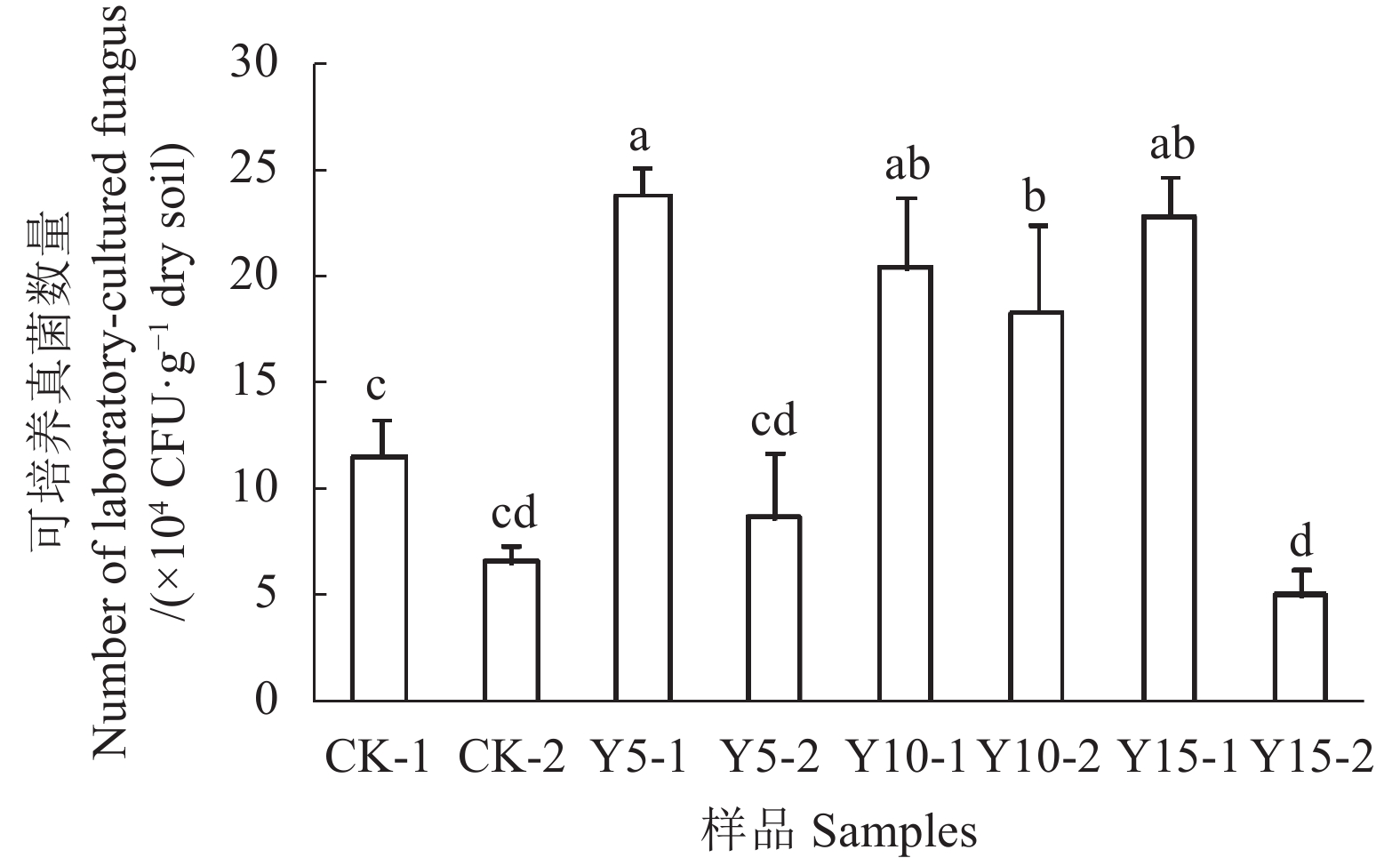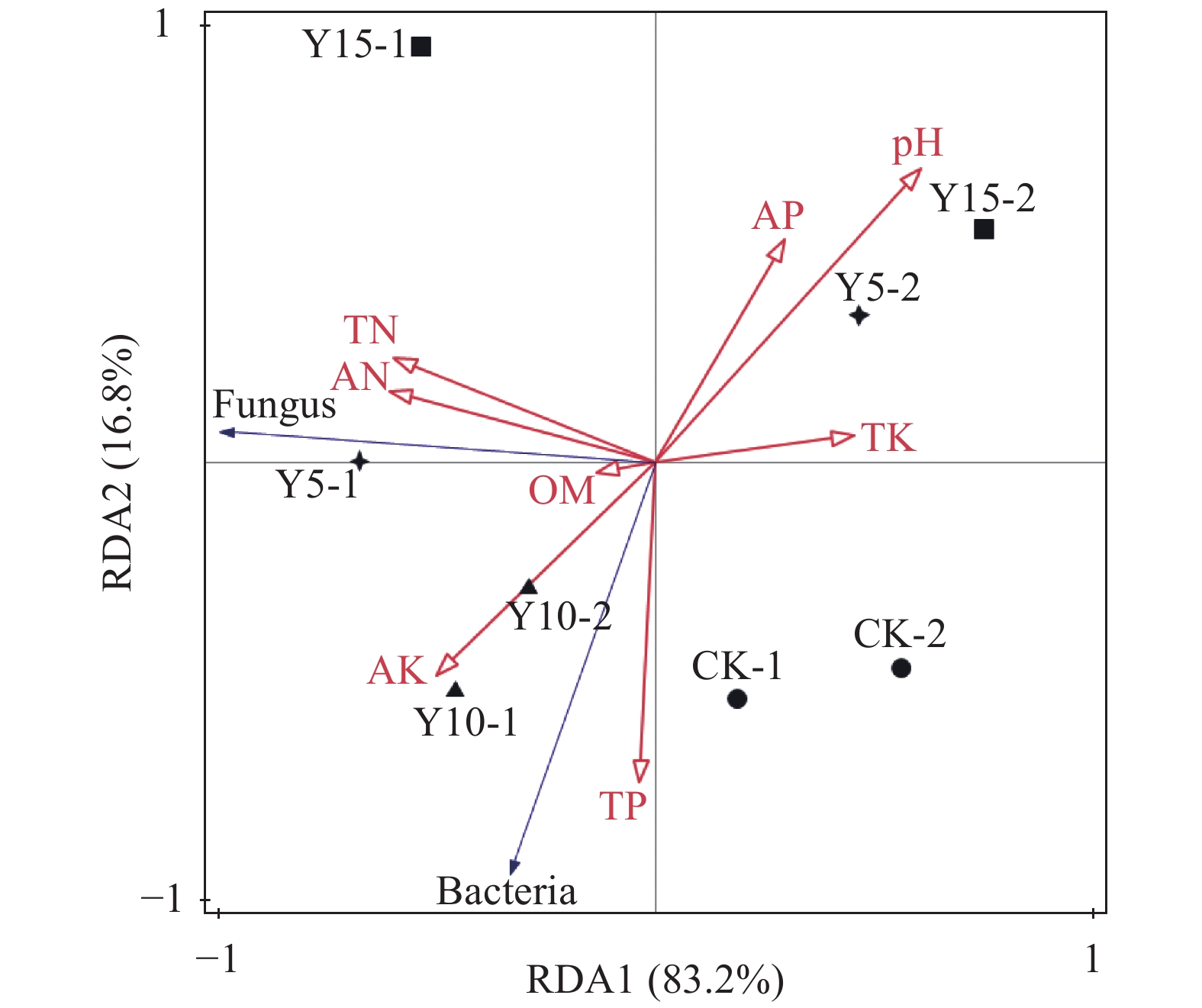Microbial Population and Fertility of Rhizosphere Soils at Areas of Varied Tea-planting Years
-
摘要:
目的 了解不同种植年限茶树根际土壤微生物数量和肥力指标之间的相关性,为茶园土壤改良和稳定生产提供依据。 方法 采用稀释平板法对武夷山茗上缘茶业有限公司试验茶园不同土层不同种植年限(5、10、15年)茶树根际土壤微生物数量进行研究,并与土壤肥力指标进行相关性分析。 结果 可培养微生物数量随着土层加深而减少;10年生茶树根际土壤可培养细菌数量最大,不同种植年限茶树根际土壤的可培养真菌数量在不同土层表现出不一样的变化趋势。茶树根际土壤酸化严重,pH值为3.14~3.36;随着种植年限的增加,各项肥力指标的变化趋势不尽相同,0~15 cm土层的全磷和全钾含量随着种植年限的增加而降低,15~30 cm土层全氮和碱解氮的含量随着种植年限的增加而增加,其他的指标则在连续种植5年或10年的时候出现最高值或最低值。冗余分析发现,可培养细菌数量主要受速效钾和全磷含量的影响,可培养真菌数量主要受全氮和碱解氮含量的影响。 结论 采样点不同种植年限茶树根际土壤微生物数量和部分肥力指标之间存在着相关性。 Abstract:Objective Correlation between the microbial community and the nutrients in rhizosphere soils of varied years of tea-planting was studied to improve soil conditions and productivity at tea plantations. Method Microbial specimens collected from the rhizosphere soils at areas where tea bushes had been planted for 5, 10 and 15 years in Wuyishan city were cultured in the lab using standard dilution-plating method. A correlation analysis was conducted between the microbial count and soil fertility at corresponding sampling spots. Result The microbial population in soil layers decreased with the depth. The counts in different soil layers at areas of different planting ages did not show a consistent pattern. The 10-year-old planting area had the highest microbial count in the rhizosphere. Acidification of the rhizosphere soils was serious showing a pH ranging from 3.14 to 3.36. The fertility indices on soils of different planting ages differed. The contents of total P and total K in the 0−15 cm soil decreased with planting age, while those of total and available N in the 15−30 cm layer increased with years of planting. Other fertility indices either peaked or bottomed out when consecutively cultivated for 5 or 10-years. The redundancy analysis on the data revealed that the bacterial plate count was mainly affected by the contents of available K and total P in soil, while the fungal count by total and available N. Conclusion There was a significant correlation between the microbial population and fertility indices (e.g., available K, available P, total N, and available N ) in the rhizosphere soils of varying years of tea cultivation at the plantations. -
Key words:
- Tea plant /
- rhizosphere soil /
- microbial count /
- fertility /
- years of tea-planting
-
图 1 不同种植年限茶树根际土壤的可培养细菌数量变化
注:图中样品名称后面的“-1”和“-2”表示不同采样深度的土壤样品。“-1”代表采样深度为0~15 cm的土壤样品;“-2”代表采样深度为15~30 cm的土壤样品。图中不同小写字母表示样品间差异显著( P <0.05)。下同。
Figure 1. Bacterial plate count of soil specimens from areas of different tea-planting years
Note: The "-1" and "-2" following the sample name indicate soil samples with different sampling depths. “-1” means the soil sampling depth is from 0 to 15 cm; “-2” means the soil sampling depth is from 15 to 30 cm. Different lowercases in the picture indicate significant difference at 0.05 level among different samples. The same below.
图 3 不同种植年限茶树根际土壤的可培养微生物数量与肥力指标的冗余分析
注:图中Bacteria代表可培养细菌数量,Fungus代表可培养真菌数量,TN、TP和TK分别代表总氮、总磷和总钾,AN、AP和AK分别代表碱解氮、速效磷和速效钾,OM代表有机质,pH即pH值。
Figure 3. RDA analysis on microbial counts and fertility indices in soils from areas of different tea-planting years
Note: Bacteria means number of laboratory-cultured bacteria; Fungus means number of laboratory-cultured fungus; TN, TP and TK mean total nitrogen, total phosphorus and total potassium respectively; AN, AP and AK mean available nitrogen, available phosphorus and available potassium respectively; OM means organic matter; and pH means the value of pH.
表 1 不同种植年限茶树根际土壤理化性质
Table 1. Physiochemical properties of soils from areas of different tea-planting years
样品
samples全氮 Total
N/(g·kg−1)全磷 Total
P/(g·kg−1)全钾 Total
K/(g·kg−1)碱解氮 Available
N/(mg·kg−1)速效磷 Available
P/(mg·kg−1)速效钾 Available
K/(mg·kg−1)有机质 Organic
matter/(g·kg−1)pH CK-1 1.30±0.00 c 0.98±0.01 a 20.64±0.15 b 104.16±0.95 b 60.00±4.04 ab 102.96±0.44 d 26.15±0.40 b 3.21±0.00 d CK-2 0.69±0.01 f 0.82±0.05 bc 15.20±0.35 c 84.17±0.24 d 57.25±0.62 bc 85.94±1.20 de 25.37±1.16 bc 3.30±0.00 b Y5-1 1.40±0.00 a 0.84±0.03 b 14.03±0.09 d 102.98±0.24 bc 50.50±1.32 d 149.70±7.68 c 30.00±0.00 a 3.25±0.01 c Y5-2 0.88±0.04 e 0.61±0.02 d 33.07±0.18 a 85.18±1.66 d 58.17±0.97 abc 145.11±4.42 c 20.31±0.44 d 3.35±0.00 a Y10-1 1.31±0.01 c 0.74±0.05 c 12.25±0.13 g 110.38±0.24 a 52.67±0.33 cd 273.15±22.48 a 18.34±0.00 e 3.14±0.00 e Y10-2 1.12±0.00 d 0.65±0.03 d 12.67±0.00 f 101.47±0.48 c 56.47±0.48 bcd 222.57±0.00 b 28.82±1.55 a 3.14±0.01 e Y15-1 1.35±0.00 b 0.59±0.00 d 12.20±0.10 g 110.04±1.19 a 63.99±6.09 a 79.16±3.22 e 24.14±0.00 c 3.30±0.00 b Y15-2 1.29±0.00 c 0.62±0.03 d 13.65±0.06 e 104.66±0.24 b 58.04±0.16 abc 77.87±0.00 e 25.77±0.75 bc 3.36±0.01 a 注:表中同列不同小写字母表示样品间在P<0.05水平上差异显著。
Note: Different lowercases in the same column indicate significant difference at 0.05 level among different samples.表 2 茶园土壤肥力评价标准
Table 2. Evaluation standards on soil fertility at tea plantations
划分等级
Classification评价指标 Evaluation indexes 全氮 Total
N/(g·kg−1)全磷 Total
P/(g·kg−1)全钾 Total
K/(g·kg−1)碱解氮 Available
N/(mg·kg−1)速效磷 Available
P/(mg·kg−1)速效钾 Available
K/(mg·kg−1)有机质 Organic
matter/(g·kg−1)pH Ⅰ级 >1.0 >0.6 >10 >100 >10 >120 >15 <4.5 Ⅱ级 0.8~1.0 0.4~0.6 5~10 50~100 5~10 80~120 10~15 4.5~5.5 Ⅲ级 <0.8 <0.4 <5 <50 <5 <80 <10 >5.5 表 3 不同种植年限茶树根际土壤肥力情况
Table 3. Fertility of soils from areas of different tea-planting years
样品 Samples 全氮 Total N 全磷Total P 全钾 Total K 碱解氮 Available N 速效磷 Available P 速效钾 Available K 有机质 Organic matter pH CK-1 Ⅰ级 Ⅰ级 Ⅰ级 Ⅰ级 Ⅰ级 Ⅱ级 Ⅰ级 Ⅰ级 CK-2 Ⅲ级 Ⅰ级 Ⅰ级 Ⅱ级 Ⅰ级 Ⅱ级 Ⅰ级 Ⅰ级 Y5-1 Ⅰ级 Ⅰ级 Ⅰ级 Ⅰ级 Ⅰ级 Ⅰ级 Ⅰ级 Ⅰ级 Y5-2 Ⅱ级 Ⅰ级 Ⅰ级 Ⅱ级 Ⅰ级 Ⅰ级 Ⅰ级 Ⅰ级 Y10-1 Ⅰ级 Ⅰ级 Ⅰ级 Ⅰ级 Ⅰ级 Ⅰ级 Ⅰ级 Ⅰ级 Y10-2 Ⅰ级 Ⅰ级 Ⅰ级 Ⅰ级 Ⅰ级 Ⅰ级 Ⅰ级 Ⅰ级 Y15-1 Ⅰ级 Ⅱ级 Ⅰ级 Ⅰ级 Ⅰ级 Ⅲ级 Ⅰ级 Ⅰ级 Y15-2 Ⅰ级 Ⅰ级 Ⅰ级 Ⅰ级 Ⅰ级 Ⅲ级 Ⅰ级 Ⅰ级 -
[1] 林生, 庄家强, 陈婷, 等. 不同年限茶树根际土壤微生物群落PLFA生物标记多样性分析 [J]. 生态学杂志, 2013, 32(1):64−71.LIN S, ZHUANG J Q, CHEN T, et al. Microbial diversity in rhizosphere soils of different planting year tea trees: An analysis with phospholipid fatty acid biomarkers [J]. Chinese Journal of Ecology, 2013, 32(1): 64−71.(in Chinese) [2] COLEMAN D C, CROSSLEY D A, HENDRIX P F. Fundamentals of Soil Ecology[M]. London: Academic Press, 1996: 48-77. [3] LOVELL R D, JARVIS S C, BARDGETT R D. Soil microbial biomass and activity in long-term grassland: effects of management changes [J]. Soil Biology and Biochemistry, 1995, 27(7): 969−975. doi: 10.1016/0038-0717(94)00241-R [4] STEENWERTH K L, JACKSON L E, CALDERÓN F J, et a1. Soil microbial community composition and land use history in cultivated and grassland ecosystems of coastal California [J]. Soil Biology and Biochemistry, 2002, 34(11): 1599−1611. doi: 10.1016/S0038-0717(02)00144-X [5] 李俊强, 林利华, 张帆, 等. 施肥模式对茶树根际土壤微生物数量及酶活性的影响 [J]. 水土保持研究, 2019, 26(3):22−28.LI J Q, LIN L H, ZHANG F, et al. Effect of fertilization regime on soil microbial quantity and enzyme activity in rhizosphere of tea [J]. Research of Soil and Water Conservation, 2019, 26(3): 22−28.(in Chinese) [6] 王秀青, 李永梅, 谢瑾, 等. 古茶园和现代茶园土壤养分与微生物数量的研究 [J]. 西南大学学报(自然科学版), 2015, 37(10):43−50.WANG X Q, LI Y M, XIE J, et al. Study on soil nutrients and quantity of microbial community of ancient tea arboretums and modern tea gardens [J]. Journal of Southwest University (Natural Science Edition), 2015, 37(10): 43−50.(in Chinese) [7] 林生, 庄家强, 陈婷等. 福建安溪不同年限茶树土壤养分与微生物Biolog功能多样性的差异分析 [J]. 中国生态农业学报, 2012, 20(11):1471−1477.LIN S, ZHUANG J Q, CHEN T, et al. Analysis of nutrient and microbial Biolog function diversity in tea soils with different planting years in Fujian Anxi [J]. Chinese Journal of Eco-Agriculture, 2012, 20(11): 1471−1477.(in Chinese) [8] 李灵, 张玉, 卢晓燕, 等. 武夷山市茶园土壤有机质的空间分布特征 [J]. 长江大学学报(自然科学版), 2019, 16(11):60−65.LI L, ZHANG Y, LU X Y, et al. Spatial Distribution of Soil Organic Matter in Tea Gardens of Wuyishan City [J]. Journal of Yangtze University (Natural Science Edition), 2019, 16(11): 60−65.(in Chinese) [9] 吴志丹, 江福英, 尤志明, 等. 亚热带茶园土壤酸度特征研究-以福建省武夷山市为例 [J]. 中国环境科学, 2016, 36(1):181−189. doi: 10.3969/j.issn.1000-6923.2016.01.030WU Z D, JIANG F Y, YOU Z M, et al. Acidic characteristics of subtropical tea garden soil: A case study in Wuyishan city, Fujian province, Southeast China [J]. China Environmental Science, 2016, 36(1): 181−189.(in Chinese) doi: 10.3969/j.issn.1000-6923.2016.01.030 [10] 陈玉真, 王峰, 吴志丹, 等. 武夷山市5种类型茶园土壤重金属剖面分布特征 [J]. 茶叶学报, 2015, 56(3):159−164. doi: 10.3969/j.issn.1007-4872.2015.03.006CHEN Y Z, WANG F, WU Z D, et al. Vertical distribution of heavy metals in five types of soils from tea plantations at Wuyishan [J]. Acta Tea Sinica, 2015, 56(3): 159−164.(in Chinese) doi: 10.3969/j.issn.1007-4872.2015.03.006 [11] 李渝, 刘彦伶, 黄兴成, 等. 贵州不同茶区土壤养分及微生物量分析评价 [J]. 灌溉排水学报, 2018, 37(8):98−105.LI Y, LIU Y L, HUANG X C, et al. Assessing soil nutrient and microbial biomass in tea plantation regions of Guizhou Province [J]. Journal of Irrigation and Drainage, 2018, 37(8): 98−105.(in Chinese) [12] 王海斌, 陈晓婷, 丁力, 等. 福建省安溪县茶园土壤酸化对茶树产量及品质的影响 [J]. 应用与环境生物学报, 2018, 24(6):1398−1403.WANG H B, CHEN X T, DING L, et al. Effect of soil acidification on yield and quality of tea tree in tea plantations from Anxi county, Fujian Province [J]. Chinese Journal of Applied and Environmental Biology, 2018, 24(6): 1398−1403.(in Chinese) [13] 李振高, 骆永明, 滕应. 土壤与环境微生物研究法[M]. 北京: 科学出版社, 2008: 90-92. [14] 国家林业局. 森林土壤pH值的测定: LY/T 1239-1999[S]. 北京: 中国标准出版社, 1999. [15] 鲍士旦. 土壤农化分析[M]. 第3版. 北京: 中国农业出版社, 2005: 30-86, 106-163.BAO S D. Soil and Agricultural Chemistry Analysis[M]. 3rd ed. Beijing: China Agriculture Press, 2005: 30-86, 106-163. (in Chinese) [16] 中华人民共和国农业部. 茶叶产地环境技术条件: NY/T853-2004[S]. 北京: 中国农业出版社, 2005. [17] 尹杰. 高产优质茶园施肥原理与技术应用 [J]. 耕作与栽培, 2007(6):52−54. doi: 10.3969/j.issn.1008-2239.2007.06.025YIN J. Fertilization principle and technology application in high yield and high quality tea garden [J]. Tillage and Cultivation, 2007(6): 52−54.(in Chinese) doi: 10.3969/j.issn.1008-2239.2007.06.025 [18] 周才碧, 陈文品. 茶园土壤微生物的研究进展 [J]. 中国茶叶, 2014, 36(3):14−15. doi: 10.3969/j.issn.1000-3150.2014.03.005ZHOU C B, CHEN W P. Research progress of soil microorganism in tea garden [J]. China Tea, 2014, 36(3): 14−15.(in Chinese) doi: 10.3969/j.issn.1000-3150.2014.03.005 [19] 张仕颖, 张乃明, 王瑾. 不同种植年限葡萄根际微生物区系及其与肥力因子的相关分析 [J]. 云南农业大学学报(自然科学版), 2015, 30(1):101−106.ZHANG S Y, ZHANG N M, WANG J. Soil microbial community of vineyard with different planting years and correlation analysis with fertility factors [J]. Journal of Yunnan Agricultural University(Natural Science Edition), 2015, 30(1): 101−106.(in Chinese) [20] 王世强, 胡长玉, 程东华, 等. 调节茶园土壤pH对其土著微生物区系及生理群的影响 [J]. 土壤, 2011, 43(1):76−80.WANG S Q, HU C Y, CHENG D H, et al. Effects of adjusting pH of tea plantation soil on indigenous microbial fauna and physiological group [J]. Soils, 2011, 43(1): 76−80.(in Chinese) -








 下载:
下载:



